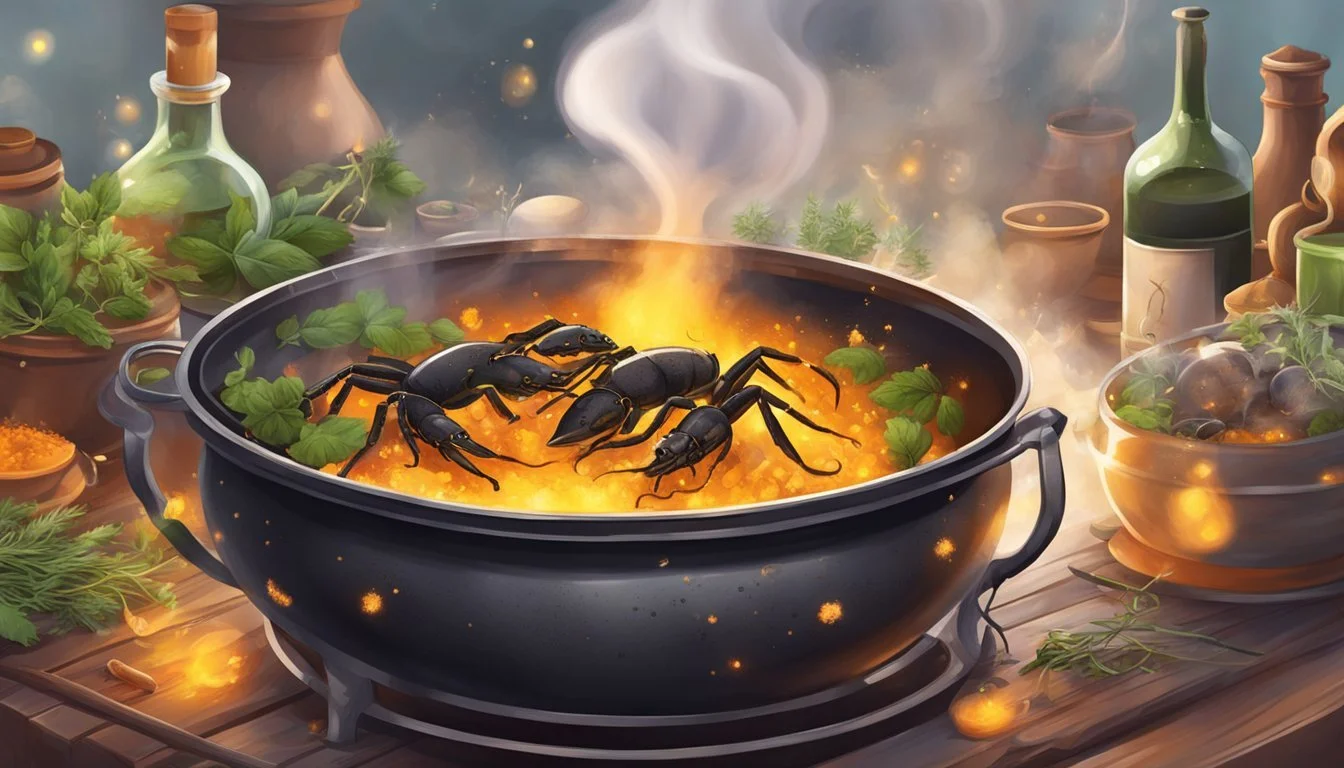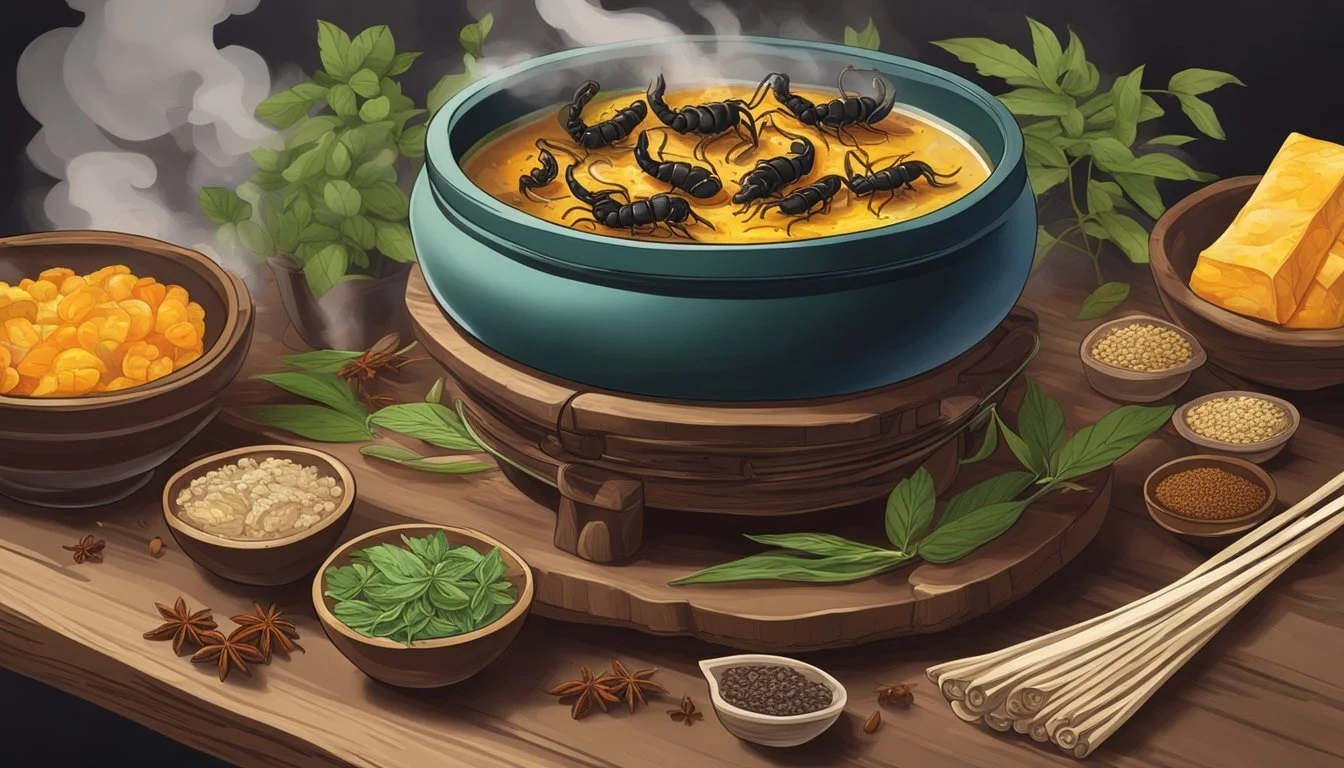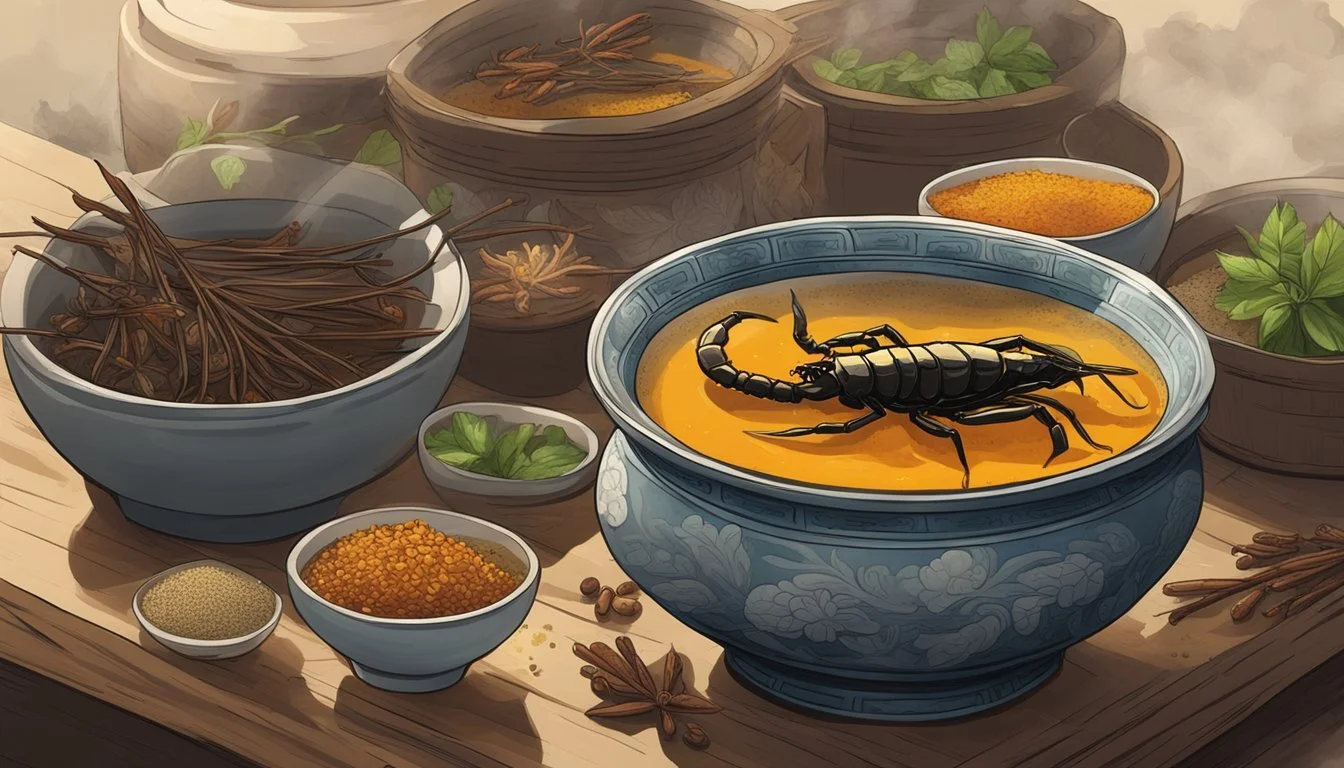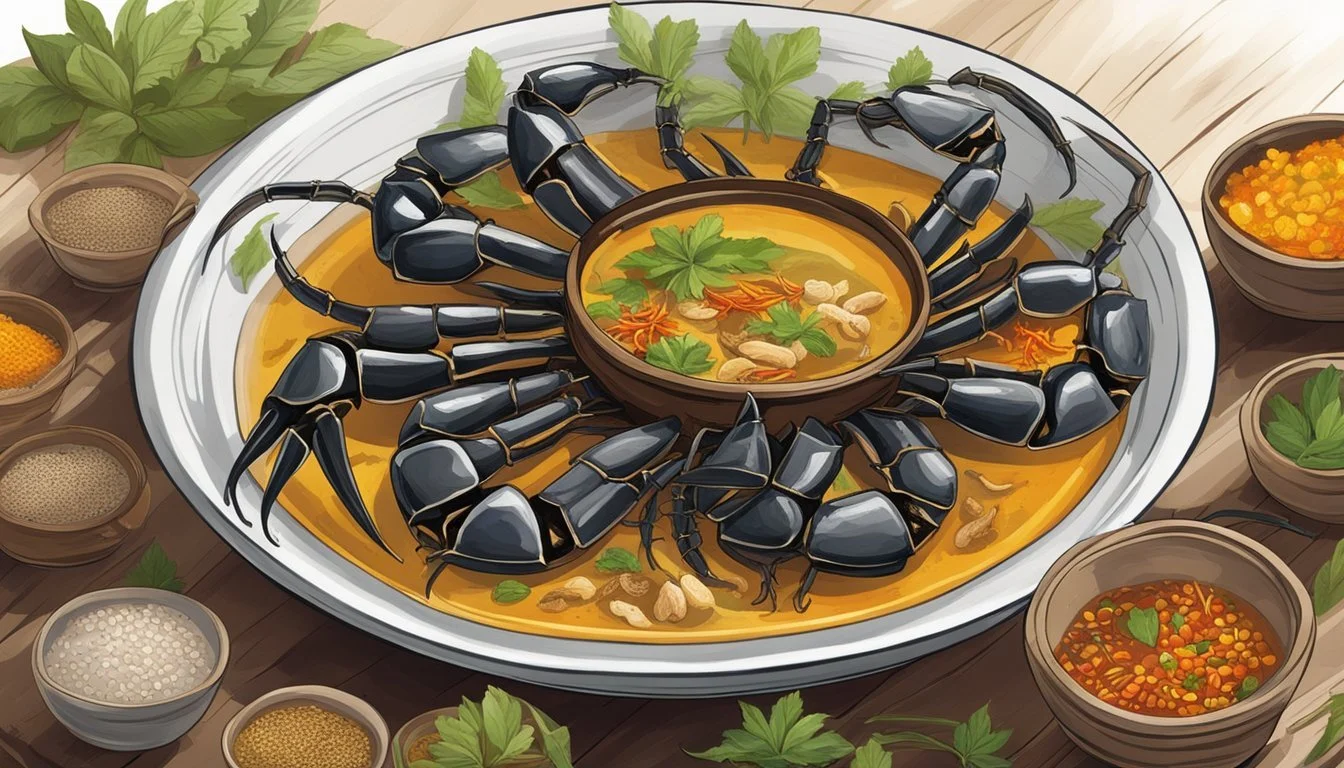Scorpion Soup Unveiling a Bold Chinese Delicacy
Scorpion soup is a dish that embodies the bold flavors and unique ingredients of Chinese cuisine. As a delicacy in Guangdong province, it combines the distinct textures and tastes of snake and scorpion, challenging the palates of even the most adventurous foodies. The soup is a testament to the diversity of Chinese culinary traditions, where the use of exotic ingredients is not only a matter of taste but also of cultural and historical significance.
The preparation of scorpion soup requires meticulous care to ensure that while the scorpion's hard exoskeleton is present, it is not harmful to consumers. Each element of the dish is carefully balanced to create a nourishing, detoxifying experience that locals believe offers various health benefits. The soup, often consumed in hotter months, is part of a broader tradition in Chinese cuisine that incorporates insects and arachnids, establishing a connection between food and natural remedies.
While the sight of the scorpion in the soup might be off-putting for some, it is a sought-after delicacy for others who appreciate the daring combination of flavors. As a reflection of the creativity and depth of Chinese culinary practices, scorpion soup remains an intriguing dish that invites curiosity and rewards the bold with a unique culinary experience.
Historical Context
Scorpion soup is a dish embedded in the rich tapestry of Chinese culinary traditions, reflecting a blend of daring flavors and a deep-seated heritage that spans thousands of years.
Origins of Scorpion Soup
Scorpion soup's emergence is deeply intertwined with China's long history of entomophagy, the practice of eating insects. This traditional Chinese soup has transformed from a dietary necessity in ancient times to a modern delicacy. While there's no specific date marking its inception, it is a testament to China's innovative culinary practices over the centuries.
Cultural Significance
In Chinese culture, eating exotic foods such as scorpions is often associated with various health benefits. Though Western palettes may shy away, scorpion soup is considered an authentic Chinese recipe with purported properties like enhancing vitality. Its preparation and consumption hold a special place in the regions that value traditional Chinese medicine and the cultural practice of turning natural resources into nourishing meals.
Health and Nutrition
Scorpion soup, an unconventional dish in Chinese cuisine, offers a unique twist with its intrepid blend of ingredients that contribute to its protein content and potential nutritional benefits.
Protein Content and Varieties
Scorpion soup can be rich in protein, depending on the variety of the dish. Commonly, the soup may feature scorpion as its exotic component, where these arthropods provide a modest amount of protein. However, scorpion is not the only protein source found in the soup. Often, the dish may include a range of meats such as pork, chicken, or beef, with each variety adding its own nutritional profile to the meal. Lean pork is especially beneficial due to its lower fat content and quality protein.
Pork: Protein Content (approx.) - 25g per 3oz, Notes - Lean cuts preferred for a healthier option.
Chicken: Protein Content (approx.) - 27g per 3oz, Notes - A common choice, offering lean protein and versatility.
Beef: Protein Content (approx.) - 26g per 3oz, Notes - Often used in the form of flank steak, which is lean.
Scorpion: Protein Content (approx.) - Lesser known, Notes - Protein content varies, not typically the main protein source.
Nutritional Benefits
The nutritional benefits of scorpion soup are closely tied to the additional ingredients that accompany the titular component. Traditional Chinese Medicine (TCM) may regard certain ingredients like ginseng as beneficial for energy levels. The meats used, such as lean pork, provide essential amino acids necessary for building and repairing tissues. Chicken introduces B vitamins important for various metabolic processes, and beef offers iron and zinc, crucial for oxygen transport and immune function.
Lean pork: Essential for muscle growth and repair.
Chicken: Source of niacin and selenium, important for energy production and antioxidant defense.
Beef: High in vitamins B12 and B6, supporting nervous system health and protein metabolism.
In summary, scorpion soup carries nutritional value that varies with its ingredients, focusing on protein provision and aligning with the principles of TCM.
Ingredients Breakdown
Scorpion soup, a dish revered for its bold flavors and unique ingredients, is as much an adventure for the palate as it is a culinary challenge for the chef. Creating this dish requires a balance of standard components and specialty items each contributing uniquely to the final taste and presentation.
Common Ingredients
The foundation of scorpion soup consists of items found in many traditional Chinese dishes. They provide the base flavors and texture to the dish:
Water: The primary liquid for the broth.
Soy Sauce: Adds a salty and umami flavor.
Sugar: Used sparingly to balance out the savory notes.
Salt: Essential for enhancing the overall taste profile.
Pepper: Offers a subtle heat to the dish.
Green Onions/Scallions: A fresh aromatic, usually used as a garnish.
Ginger: A pungent spice that adds warmth and zest.
Garlic: Provides a robust flavor to the soup.
Vegetables: Common additions include carrots and bamboo shoots for crunch.
Tofu: Adds proteins and takes on the flavors of the broth.
Mushrooms: Typically shiitake or other earthy varieties give a meaty texture.
Egg: Sometimes used to thicken the broth.
Specialty Ingredients
Unique to scorpion soup, these ingredients are what set the dish apart and often require seeking out from specialized markets:
Scorpions: The star of the dish, incorporated for their texture and novelty.
Wood Ear Mushrooms: Provide a jelly-like consistency and distinct earthiness.
Bamboo Shoots: Valued for their crisp texture and sweet flavor.
Seaweed: Contributes a briny depth to the soup’s profile.
Sesame Oil: Used sparingly, it infuses the soup with a nutty aroma.
Corn: Sometimes added for sweetness and to thicken the broth.
Each ingredient serves the purpose of enhancing the complex character of the soup, making it a delectably daring experience.
Preparation Techniques
The preparation of Scorpion Soup is precise and designed to balance its unique flavors and textures. Extensive knowledge and attention are required, especially when handling the scorpion, the key ingredient that sets this dish apart.
Cooking Methods
Scorpions need to be thoroughly cleaned and coated in all-purpose flour before being deep-fried until golden and crispy. This step not only ensures the elimination of bacteria but also gives the scorpions a desirable crunch. Meanwhile, a rich chicken stock serves as the base of the soup. The stock is brought to a gentle simmer, and pre-treated scorpions are introduced into the liquid. Careful regulation of temperature is crucial, as the goal is to infuse the broth without overcooking the delicate ingredients.
Flavor Enhancement
The overarching goal in enhancing the flavors of Scorpion Soup is to complement the dish's inherent boldness without overshadowing the main ingredient. A thickening agent, typically cornstarch, is dissolved in water and added to the soup to improve its texture. For a spicy kick, chili oil is drizzled in, while black pepper and white pepper are used judiciously to season the dish without overpowering it. The balance of spices and the velvety consistency achieved through the careful incorporation of starch are testaments to the chef's expertise. Flavor enhancement is not only about adding to the taste but also about creating a harmonious experience that respects the traditional aspects of a daring culinary adventure like Scorpion Soup.
Soup Variations
The world of Chinese soup is diverse and expansive, offering a range of flavors from the comfortably familiar to the thrillingly unconventional. Regional cooking styles and modern culinary innovation have both played roles in the evolution of these soups (What wine goes well with soups?).
Regional Variations
Different regions of China offer unique twists on traditional soups that reflect local ingredients and preferences. For instance, Hot and Sour Soup from Sichuan is profoundly spicy and tangy, often containing tofu, mushrooms, bamboo shoots, and a beaten egg to create a silky texture. In contrast, the Cantonese version might be less spicy, favoring a balance of sourness with a greater emphasis on the soup's broth.
Wonton Soup is another classic, varying mainly by the dumpling fillings and broth seasonings from region to region. In Shanghai, one might find bok choy and shrimp-filled wontons, while a soup from Guangdong could feature a lighter broth with pork dumplings (What Wine Pairs Best with Pork Dumplings).
Modern Twists
As culinary boundaries continue to blur, modern takes on these ancient recipes have emerged. Chefs are introducing vegetarian versions of classics, replacing meats with tofu and mushrooms to cater to diverse palates while still capturing the essence of the original dish. A good example is a vegetarian Wonton Soup, where the traditional pork and shrimp fillings are substituted with a mixture of mushrooms and vegetables.
Tomato Egg Drop Soup is a modern variant that tugs at the heartstrings of comfort, with luscious bits of tomato harmonizing with the delicate egg ribbons. Similarly, the Chicken Corn Egg Drop Soup is a modern fusion beloved for its comforting qualities, combining the sweetness of corn with the richness of chicken, all suspended in a velvety egg-flower broth.
Innovation doesn't stop there. Some chefs are creating hybrids like the Chinese Winter Melon Soup, infusing it with modern flavors or using techniques borrowed from other culinary traditions, to keep the adventurous diner engaged.
Dining Experience
The scorpion soup dining experience, regarded as a daring venture into the world of exotic cuisines, offers diners a distinct flavor profile and presentation, whether enjoyed in a restaurant setting or bravely prepared at home.
In a Restaurant Setting
In restaurants that feature scorpion soup, patrons can expect a theatrical presentation that often becomes the centerpiece of the meal. The dish is typically prepared by skilled chefs who source their ingredients meticulously, ensuring that scorpions are safe for consumption after being detoxified. Takeout options for scorpion soup may be limited due to the intricate serving methods involved. Servers might provide chopsticks and soup spoons, and often guide novices through the process of eating this delicacy. As a restaurant favorite, the soup is often garnished skillfully to enhance both visual appeal and taste.
Cooking Notes:
Scorpions detoxified and prepared properly
Garnish: Typically includes traditional elements to complement the dish
Restaurant Tips:
Use provided chopsticks for precision
Try broth first to acclimate to the unique flavors
Homemade Scorpion Soup
For culinary adventurers looking to recreate this experience at home, scorpions can sometimes be sourced from Asian grocery stores or niche vendors on Amazon. Homemade versions of the soup provide an opportunity to customize the robustness of the dish. Posting the process on social platforms such as Instagram, Facebook, or Pinterest may even inspire others to take on the challenge. Cooking notes often suggest a strong broth as the base and emphasize careful handling of the scorpions.
Where to Buy:
Asian Grocery Stores: Check for availability
Online: Specific vendors on Amazon
Social Sharing:
Share your experience on Instagram or Facebook
Post recipes and cooking tips on Pinterest
Culinary Culture
Scorpion soup is a distinctive part of Chinese culinary tradition, integrating the essence of Chinese soups with an adventurous twist that challenges the palate.
Soup in Chinese Cuisine
Chinese cuisine holds soup in high regard, often starting meals with a warm bowl to stimulate digestion. Traditional Chinese soups, like many culinary practices in China, are not just about quelling hunger but revolve around the philosophy of nurturing the body. They frequently leverage a base of Asian vegetable stock, which is accentuated with an array of ingredients such as:
Vegetables: Common choices include leafy greens, root vegetables, and gourds.
Mushrooms: Dried shiitake mushrooms and wood ear are revered for their texture and depth of flavor.
Herbs and Spices: These are selected for both their medicinal qualities and their flavor.
Utilizing recipes passed down through generations, Chinese soups blend these components to create a harmonious and nutritious dish.
Scorpion Soup in Pop Culture
Scorpion soup, while less known globally, is infamous in pop culture for its exotic and daring nature. It is often portrayed as a culinary challenge for travelers and food enthusiasts alike. The scorpion, after preparation, is immersed in a rich, aromatic broth, which is a combination of traditional Chinese soup elements:
Broth: A robust stock typically made from chicken or pork bones, sometimes fortified with Asian vegetable stock.
Add-ins: A variety of veggies are included to enhance the texture and nutrition of the soup.
Mentioned occasionally in media and travel shows, scorpion soup embodies the daring side of culinary exploration, suggesting an experience that tests one's courage as much as it excites the taste buds.
Consumer Insights
Scorpion soup is a dish with a niche appeal, often found in areas of China known for daring culinary traditions. Consumers interested in exotic and unique culinary experiences are drawn to this dish for both its novelty and traditional aspects.
Availability and Accessibility
Scorpion soup is most commonly available in certain regions of China, particularly in the southern areas where eating insects is more customary. The soup may contain ingredients such as dried or fresh mushrooms, which provide a savory broth base, often complemented by additional proteins such as pork meatballs or mongolian beef for a more filling and flavorful meal. During winter months, the soup is sought after for its warming qualities and the use of hearty ingredients like pork rib. In terms of accessibility, the dish can be elusive outside of China, requiring consumers to visit specialized Chinese eateries or street food vendors to sample this delicacy.
Local Availability: Primarily in southern China
Common Ingredients: Mushrooms, pork, and sometimes beef
Seasonal Variation: Increased demand in winter
Trends and Popularity
As adventurous eating gains traction globally, dishes like scorpion soup are entering the foodie limelight. This soup is not only a test of daring but also a dive into traditional Chinese culinary practices. Trend-watchers have noted an uptick in the dish’s popularity among tourists seeking authentic experiences. Moreover, scorpion soup can be a conversation starter about sustainable protein sources, as insects are a low-impact alternative. Despite this, the dish maintains a relatively low profile compared to more universally palatable soups such as shepherd’s purse tofu soup or easy fish tofu soup, which feature accessible flavors like cilantro and comforting glass noodles.
Interest Among Tourists: Growing curiosity
Comparative Popularity: Less popular than more conventional soups
Sustainability Conversation: Part of a broader discourse on alternative proteins









